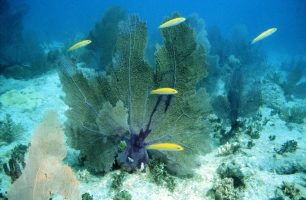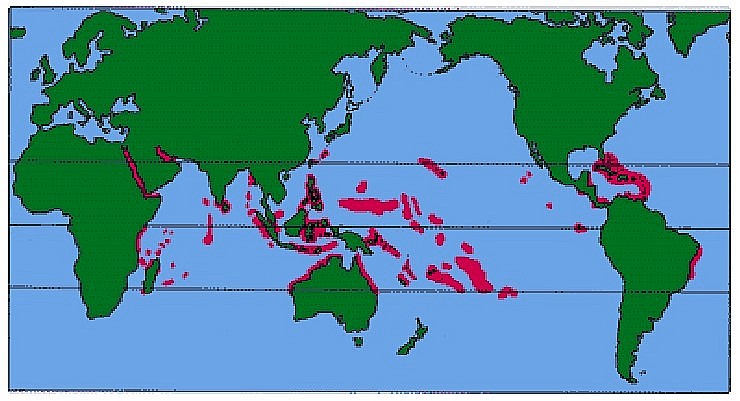

What is a Coral Reef?

There Are More Kinds of Life on a Coral Reef Than Anywhere Else on the Planet
Coral reefs are the most biologically diverse marine eco-systems on earth, rivaled only by the tropical rainforests on land. That means there are more kinds of life on a coral reef than anywhere else on the planet. Coral reefs occupy less than one quarter of one percent of the earth's marine environment, yet they are home to more than a quarter of all known fish species. They are delicately balanced marine environments that rely upon the interaction of hard and soft corals, sponges, anemones, snails, rays, fish, crabs, lobsters, turtles, dolphins and other sea life.
Corals grow over geologic time and have been in existence at least 200 million years, some scientists say 400 million years. Corals reached their current level of diversity 50 million years ago.
What is a coral reef made of?
A coral reef is composed of thin plates or layers of calcium carbonate secreted over thousands of years by billions of tiny soft bodied animals called coral polyps. It takes years for some corals to grow an inch and they range in size from a pinhead to a foot in length. Each polyp excretes a calcereous exo-skeleton and lives in a symbiotic relationship with a host algae, zooxanthellae, that gives the coral its color. Zooxanthellae takes in carbon dioxide, process is through photosynthesis, and then gives off oxygen as a by-product that is used by the host polyp. Millions of polyps grow on top of the limestone remains of former colonies to create the massive reefs. Yet these tiny animals form the only natural formation visible from outer space.

Corals are divided into two kinds and both are stationary on the ocean bottom. Hard corals such as brain, star, staghorn, elkhorn and pillar corals have rigid exoskeletons, or corallites, that protect their soft delicate bodies. They form the main structure of a coral reef. Gorgonians, or soft corals, such as sea fans, sea whips, and sea rods, sway with the currents and lack an exoskeleton. They are filter feeders and help improve water quality.
Hard & Soft Corals

Coral Reefs Depend Upon Mangroves and Sea Grasses
Coral reefs are part of a delicate marine ecosystem that also includes mangroves and seagrasses; each depends upon the other to survive.
Mangroves are salt-tolerant trees with submerged roots that are a nursery and breeding ground for birds and most of the marine life that later migrates to the reef. Many species of fish are bred in the mangroves and then move to the seagrasses for their juvenile stage. Mangroves trap and produce nutrients for food and habitat, stabilize the shoreline, and filter pollutants from the landbase.
Seagrasses are flowering marine plants that are an important part of the food web. They provide food and habitat for turtles, manatees, many fish, filter-feeding organisms and foraging sealife such as sea urchins and sea cucumbers. And of course sea turtles depend upon turtle grass. Seagrasses are a nursery and breeding ground for pink shrimp, lobster, snapper and other sealife. They filter the water of sediments, release oxygen and stabilize the ocean bottom, improving water quality for corals and other marinelife.

Coral reefs deserve protection for their intrinsic natural value. In addition, the economic, tourism, fishing and recreational resources of tropical areas around the world depend upon healthy coral reef ecosystems. Barrier coral reefs protect shorelines from erosion and storm damage. The food, tourism revenue, coastal protection and new medications that reefs provide are worth about hundreds of billions of dollars each year.
Why Are Coral Reefs Important?





Why Does the Coral Reef Need Protection?
Reefs at Risk: A Map-based Indicator of Threats to the World's Coral Reefs, produced by the World Resources Institute in collaboration with the International Center for Living Aquatic Resources Management (ICLARM), the World Conservation Monitoring Centre (WCMC) and the United Nations Environment Programme (UNEP), is the first goal assessment of coral reefs to map areas at risk from overfishing, coastal development, and other human activity ranging from coastal development and overfishing to inland and marine pollution -- leaving much of the world's marine biodiversity at risk. Go to:

Coral Reef Hotspots Around the World
Coral reefs are suffering globally. Scientists report that 40% are already damaged. Corals grow only in warm tropical waters. Although climatic and geological changes affect them, human activities have had far greater consequences over the past decade. The first generation to discover scuba may be the last to enjoy coral reefs, if we don't get involved. Corals are damaged by a variety of physical impacts that include anchor damage, accidental boat groundings, and diver/snorkeler touching, standing and dragging equipment. Propellors tear up shallow seagrasses. Marine debris, especially plastics, damage marinelife and smother corals. Turtles mistake plastic bags for their favorite food, jellyfish.
Water quality declines when pollution discharges from boats or coastal areas. This reduces visibility and oxygen, and increase chlorophyll levels causing a proliferation of new coral diseases and massive algal blooms. Coral bleaching occurs when sea temperatures rise or other stresses occur and the corals expel their symbiotic algae. Ocean acidification reduces the conditions needed for healthy coral exo-skeleton development.
Siltation from coastal development and beach renourishment smothers fragile corals. Agricultural run-off that contains pesticides and fertilizers add toxins and nutrients to reefs that require nutrients-free waters to thrive. Overdevelopment and lack of sewage and stormwater infrastructure in coastal areas is a leading source of damage to reefs.
Outright habitat loss occurs when coral and live rock is harvested for construction or the aquarium/curio trade. Destructive fishing techniques and overharvesting of fish and tropical marinelife is a worldwide problem.
If the biota, in the course of aeons, has built something we like but do not understand, then who but a fool would discard seemingly useless parts? To keep every cog and wheel is the first precaution of intelligent tinkering. Aldo Leopold, Round River, 1993.
Reef Relief Founders.com


